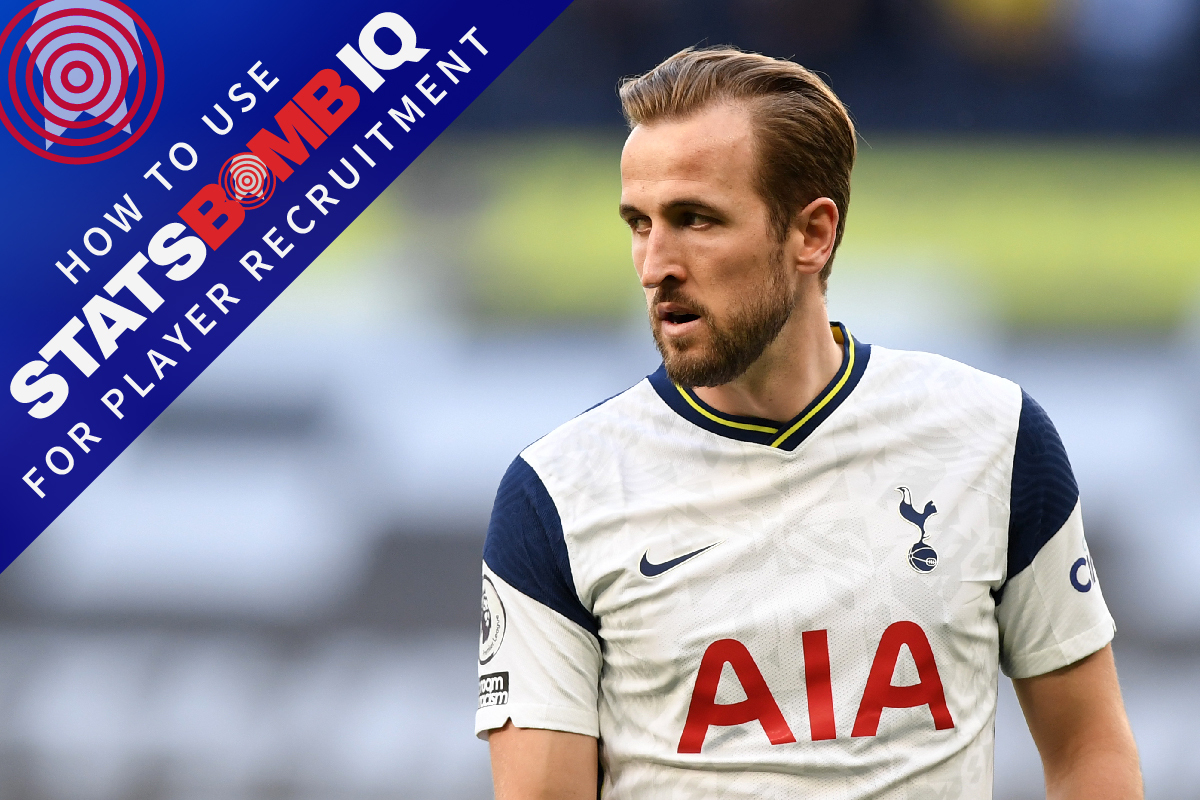Right now, dozens of clubs around the world will be using StatsBomb IQ to aid their player recruitment planning and shortlisting ahead of the summer transfer window. IQ is designed by analysts, for analysts, with the goal of making data-driven insights easily accessible and digestible. Most importantly, it saves valuable time and resources for the time-poor analyst and is flexible and customisable to each user's specific needs.
Data can be used at all stages of the recruitment process, from the initial shortlisting down to more granular player assessments, to support qualitative live and video scouting and background personality checks. Today we're going to show you some examples of how IQ can be used to bring data into the recruitment process in the early stages when creating a scouting shortlist. Let’s look at a couple of Premier League forwards with different player profiles and role requirements. Given the rumours swirling around White Hart Lane at the minute, it seems likely that Tottenham might currently be in the process of drawing up contingency plans should Harry Kane depart for pastures new.
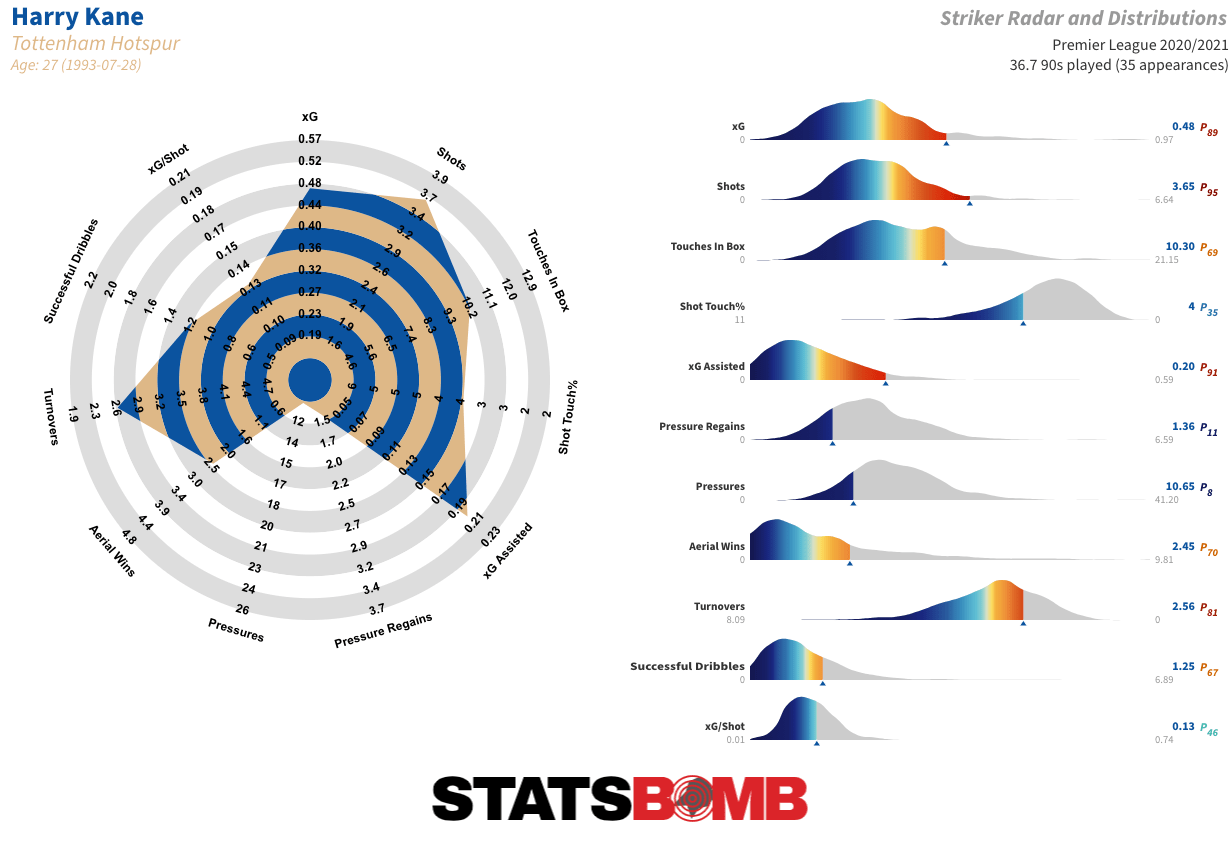
It goes without saying that Kane is vitally important to Spurs, being one of the best forwards in the world. Kane was the only player in the Premier League to hit both 0.20 xG per 90 *and* 0.20 xG assisted per 90 in the 2020/21 season. We want to create a shortlist of players that could be worth further investigation as potential replacements for the England striker. Spurs might be thinking about doing this in a number of different ways, replacing him with multiple players or adapting their style of play to bring the best out of other players, for example, but for the purposes of this exercise, let’s assume they’re looking for a direct replacement.
1) Create And Edit A Radar Template
The first thing we want to do in IQ is create a radar template that best reflects Kane’s output as a forward. We know that Kane takes on what you might call a “complete” role up front for Tottenham; dropping deep to be involved in build-up, providing creative link-play in the final third, whilst also being the team’s main goal threat. To do this, we select the “Edit Radar Template” function in IQ, choosing the relevant positions we want the data to filter for.
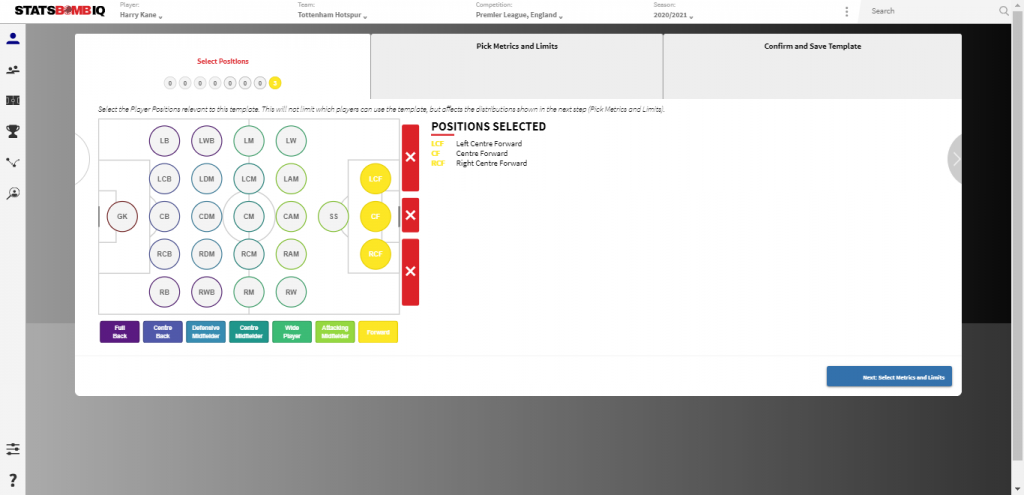
Next, we select the relevant metrics with which we want to judge Kane’s performances against and that will be used in the search for his potential replacement.
As an indicator of his ball progression and build-up play, we'll add Deep Progressions (the number of times the player moves the ball into the final third through a pass or dribble) to the original Striker radar template. As measures of his final third link play, we'll add Open Play Passes Into The Box as well as Open Play Key Passes. His goal threat will be measured by his Expected Goals and Shots totals.
Once our metrics are selected, we choose the radar percentile boundaries based on the distribution of data in each metric by the relevant positions we've chosen, in this case strikers.
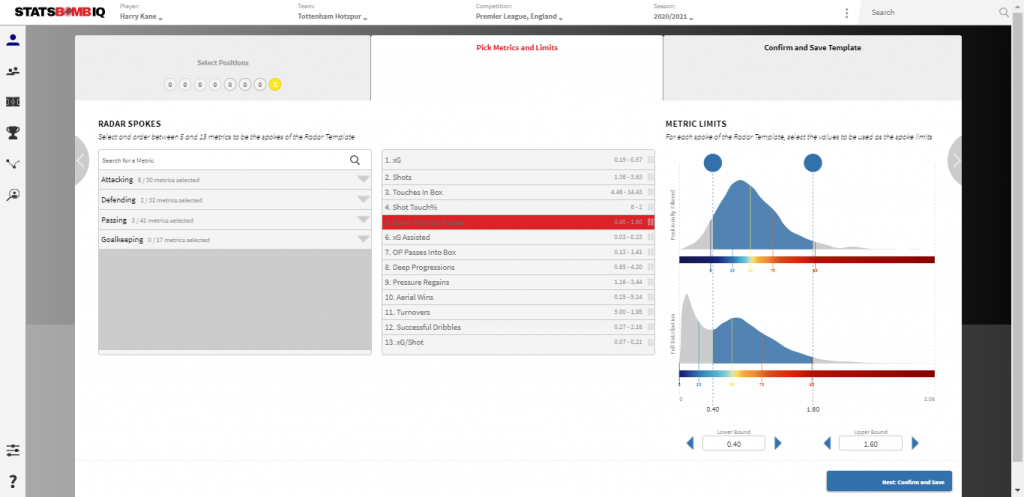
When we’re happy with the metrics we’ve selected and layout of our radar, we can save the template for future use, and view the player on our newly created radar.
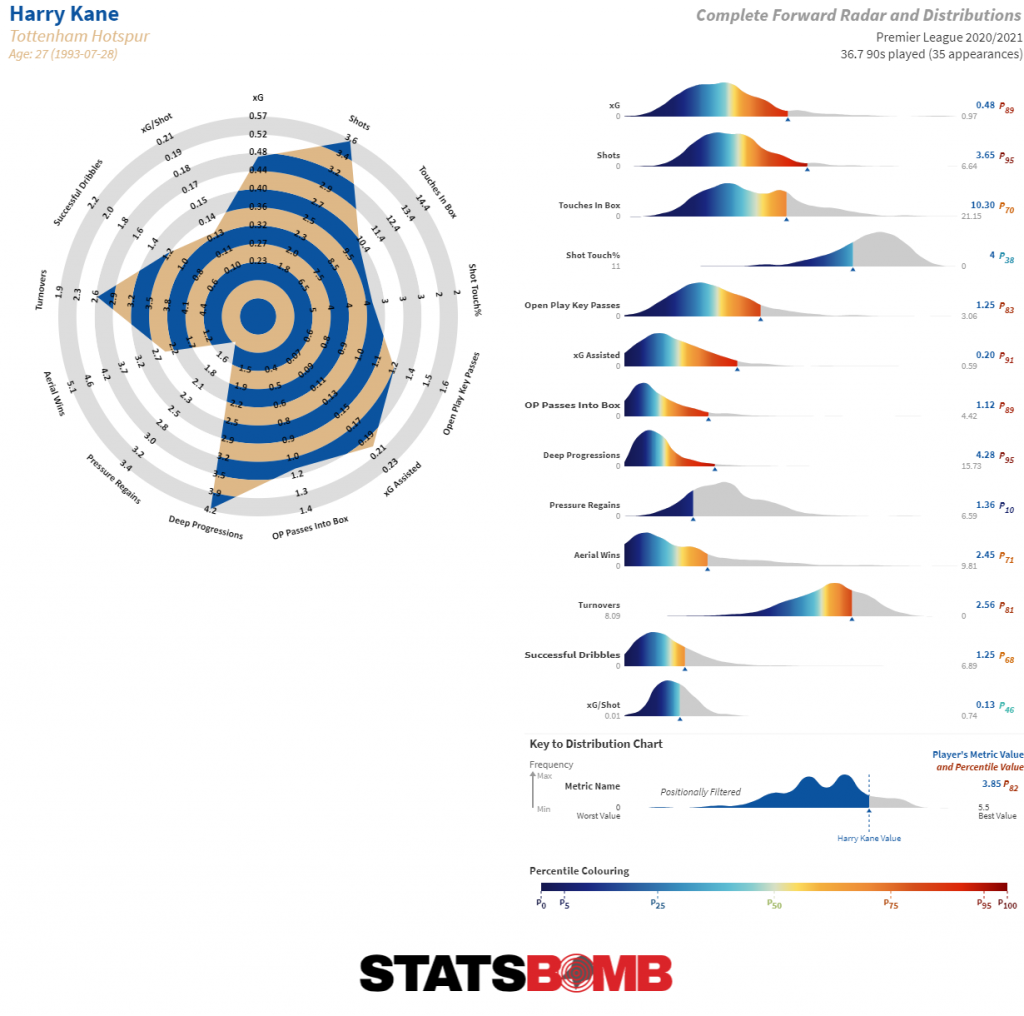
The new radar provides an accurate overview of Kane’s performances in the 2020/21 season against the criteria we' looking to judge:
- Goal Threat: 89th percentile for Expected Goals, 95th percentile for Shots
- Involvement In Build-Up: 95th percentile for Deep Progressions
- Final 3rd Link Play: 89th percentile for Open Play Passes Into The Box, 83rd percentile for Open Play Key Passes, 91st percentile for xG Assisted
We now have a radar that reflects Kane’s outputs. But how can we use this to aid our search for potential replacements?
2) Use StatsBomb IQ’s Similar Player Search Tool
The first thing to do in Similar Player Search is to set the filters for potential replacements. StatsBomb cover 80+ competitions worldwide, but Spurs will obviously be looking towards the top of the market for a possible new striker. For the purposes of this exercise, we’re going to look at players from:
- the 2020/21 season
- with a minimum of 1500 minutes played
- in a Big 5 league + Austrian Bundesliga, Portuguese Liga NOS, and English Championship
- and no older than 24 years old
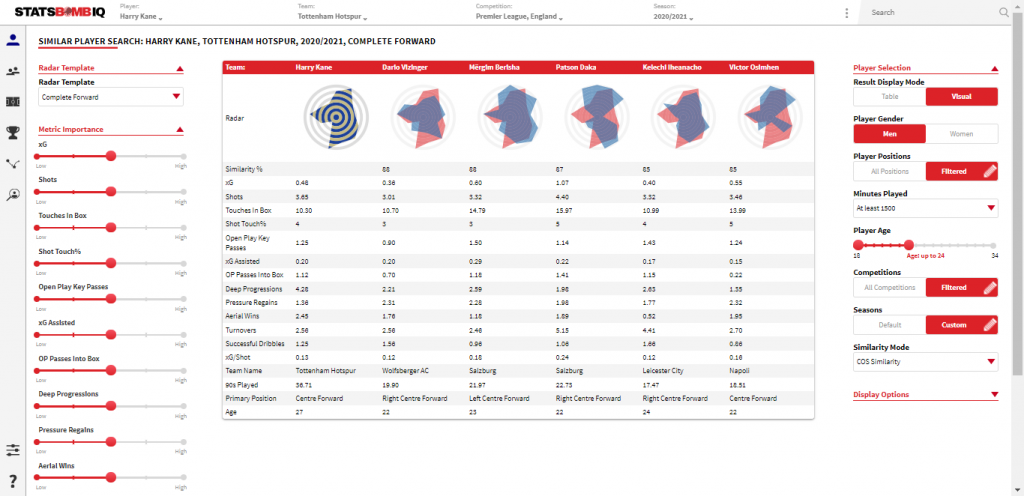
The top 5 most similar players make for interesting reading, with perhaps Salzburg’s Patson Daka the most eye-catching given the rumours that he’s likely to follow Erling Haaland as the next forward off the Salzburg production line. Slightly different in style to Kane, Daka is more involved on the end of chances - as reflected by his Shot Touch % of 5% (the percentage of his touches that are shots) - and less involved in the build-up play, reflected by his 2.0 deep progressions per 90 minutes (compared to Kane's 4.3). However, the Zambian plays in a transition-heavy team (worth noting if Spurs are looking to stick with that style) and has shown consistent quality on the European stage. He might be worth consideration.
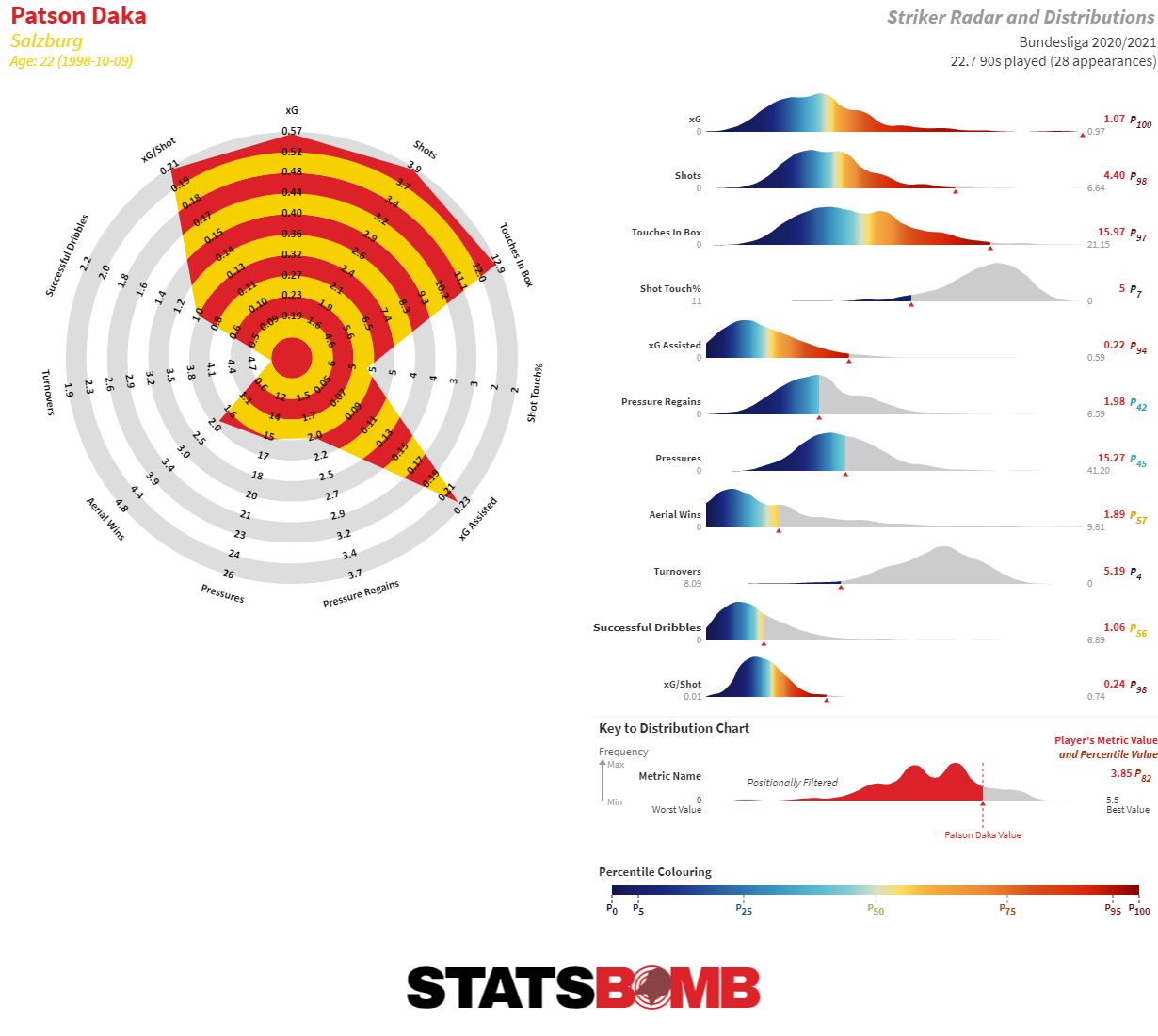
If we were to place more weight on the build-up and link-play metrics, names such as Amine Gouiri, Rafael Leão and João Félix appear closer to the top of the search. Some more realistic than others, but again perhaps worth further scouting and analysis from the Spurs recruitment team. On the criteria selected, 64 names were produced. We can export the shortlist with each of their similarity scores and outputs in the selected metrics attached to a .csv file for a more detailed look, whittling the names down based on their performances and potential availability.
There's still more we can do in IQ to increase our initial shortlist size.
3) Use IQ Scout
IQ Scout is the recently upgraded scouting and recruitment tool within the StatsBomb IQ platform. We can use IQ Scout to find more players that may not have been flagged in our Similar Player Search, using filters to bring the list of players down to a manageable and relevant number. The first thing to do in IQ Scout is to select the radar template we’ve just created so we can filter our shortlist based on those metrics. Setting a benchmark of:
- 2.0 Shots per 90
- 0.30 xG per 90
- 0.08 xG Assisted per 90
- 1.0 Open Play Key Passes per 90
… returns a shortlist of 12 players that we can be confident are worthy of further investigation.
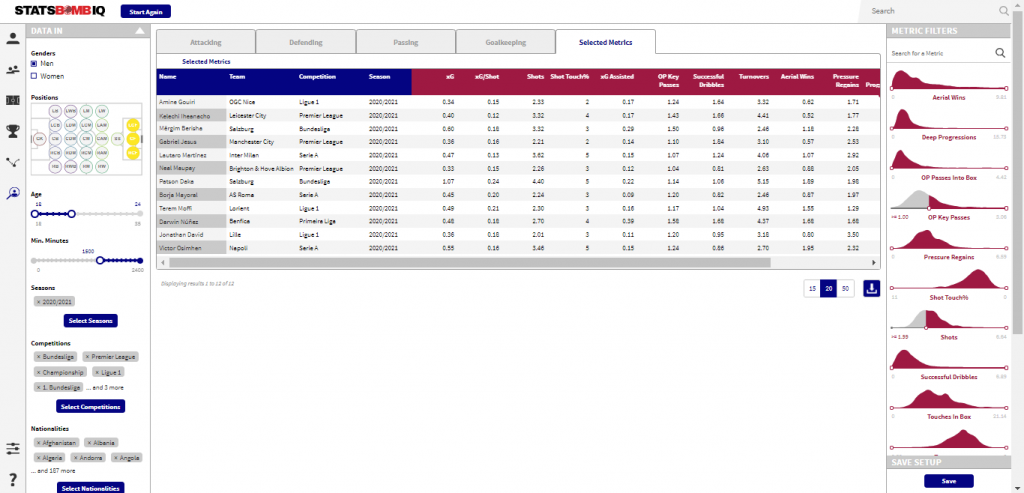
Altering the filters slightly towards a more creative type of forward returns a list of 15 names, mostly new ones. We can change or loosen the filters as much as we want based on which we want to weight more heavily. Do we want a well-rounded forward who performs to at least an average level across a range of metrics? Or do we want one who is elite in a couple of highly important ones?
Once again, we can export the shortlists for further analysis and scouting, with the file containing the player's performances across every StatsBomb metric.
To demonstrate the flexibility of StatsBomb IQ to each user's needs, we can repeat the process for a forward with a slightly different profile to Harry Kane. Leeds’ Patrick Bamford is another prolific English goalscorer in the Premier League, but his role in the Leeds team is different to that of Kane’s. Bamford is relied upon to consistently find space in the box, be a finisher of the team’s chances rather than create them, and provide a high work rate out of possession in Marcelo Bielsa’s system.
We can create a radar template that best reflects Bamford’s outputs in the Leeds team and the type of player we’re searching for. The key metrics we'll be judging Bamford and his potential replacements against will be:
Find Space In The Box:
- Touches In Box
Finisher Of Chances:
- xG
- Shots
- Shot Touch %
Defensive Work Rate:
- Pressures
- Pressure Regains
- Counterpressures
- Possession-Adjusted Tackles & Interceptions
Again we can set the radar percentile boundaries based on the data filtered by each position, so we can see the 5th and 95th percentiles for counterpressures by strikers, for example, and then save our template for future use.
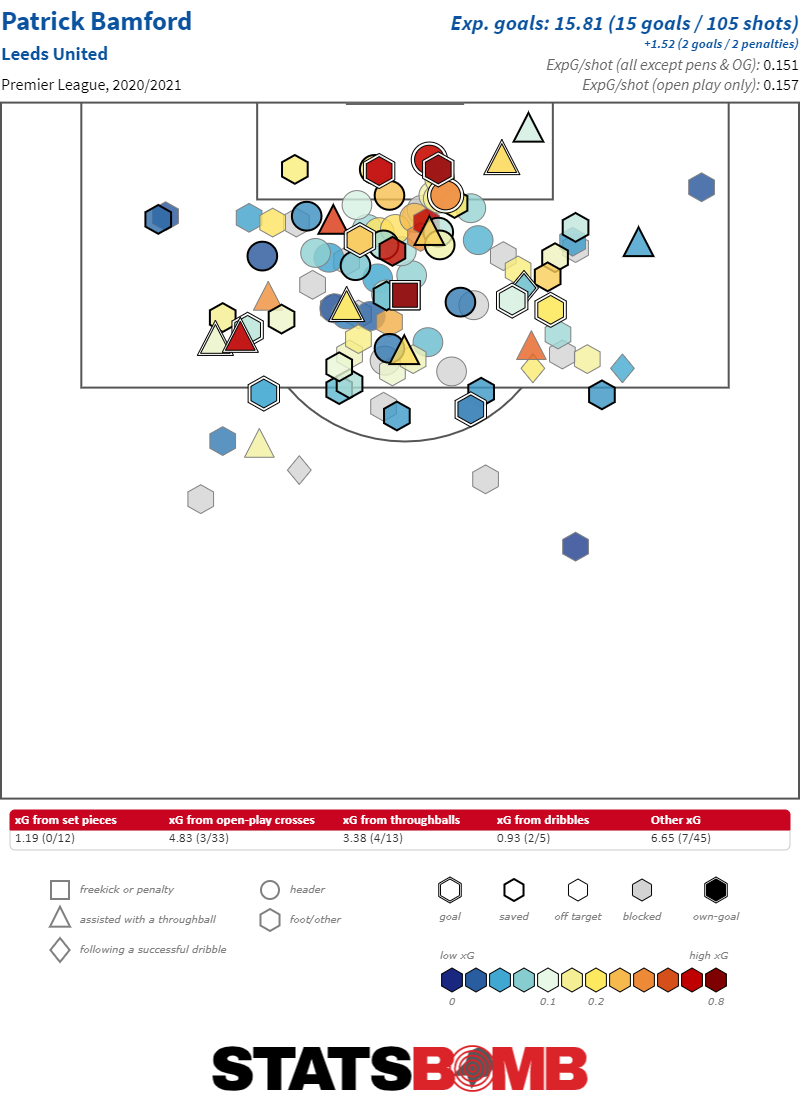
We can see that Bamford performs well in the metrics we’ve highlighted as being important to a player of his role and requirements: in the 96th percentile for Touches In The Box, the 88th percentile for Pressure Regains, and with a Shot Touch % of 5%. The Similar Player Search (using the same criteria as used for Kane but with the Eredivisie and Belgian Pro League added) returns some high-profile (and likely expensive) names. Danilo of FC Twente (on loan from Ajax) could be the most attainable of the top five, but not far further down the list you find Youssef En-Nesyri of Sevilla and Adam Armstrong of Blackburn, for example.
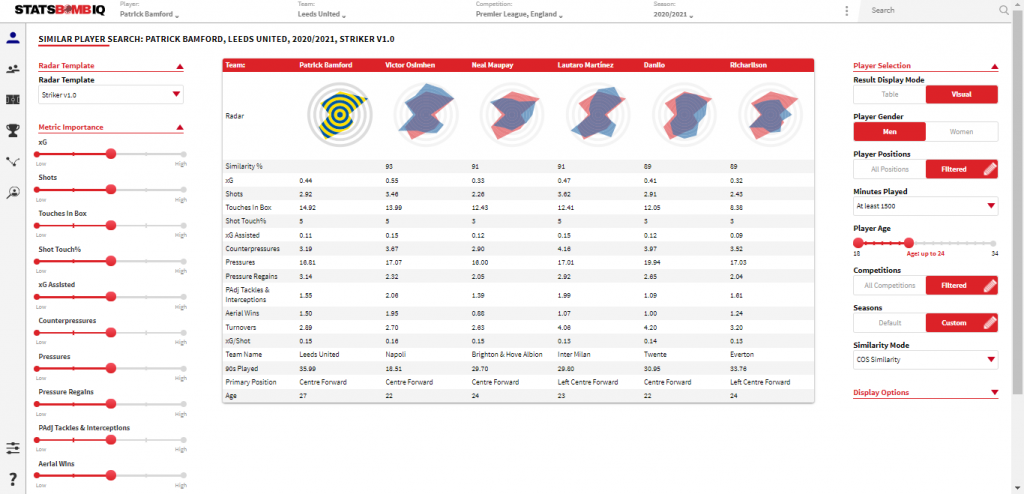
We can export the shortlist and then head into IQ Scout to widen our pool of players. Selecting the same competition, age, and minutes played filters and applying further filters on our metrics with a minimum of:
- 2.0 Pressure Regains per 90
- 13.5 Pressures per 90
- Shot Touch % of 3%
- 10 Touches In Box per 90
- 0.2 xG per 90
…returns a list of 16 names that we can be confident will be close to the style of player we’re searching for, again allowing the option to loosen or change the filters if we want to widen or reduce our shortlist, and also allowing us to export the list of players for further analysis and scouting, with the players' performance in each StatsBomb metric listed within the exported file.
That’s just a glimpse of how StatsBomb IQ can be used for player recruitment and shortlist creation, prior to the deeper analysis we can perform within IQ once we’ve identified our targets, alongside live and video qualitative scouting and background personality and availability checks. Later in the week we’ll look at different positions to further demonstrate how StatsBomb IQ can be customised to fit the precise profile of player you're looking for.
If you’re a football club or organisation and would like a full demo of how StatsBomb IQ and Data can help you achieve your objectives, get in touch with us today.
